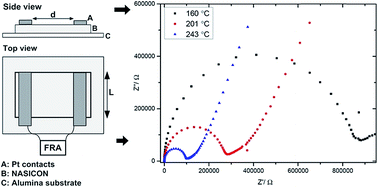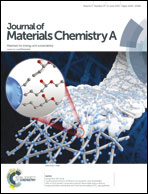New insight into the electrical properties and ion dynamics of screen printed NASICON thick films
Abstract
Although AC conductivity measurements of NASICON are well documented in the literature, thick film conductivity and ion dynamic studies, important for planar gas sensors, are scarcely reported. Most thick film measurements are performed using four point probe methods (DC method) and are quite limited in that they can't give information on ion dynamics and cannot separate contributions from grains, grain boundaries and electrode effects. However, in this paper we report the electrical properties of NASICON, x = 1.95 thick films of different thicknesses (20–32 μm), screen printed on alumina substrates, in light of ionic dynamics using the AC conductivity formalism. Surface resistivities of thick films from impedance data in the frequency range 0.1 ≤ f(HZ) ≤ 3.2 × 107 are obtained. Impedance Cole–Cole plots show grain interior and electrode effects. The hopping frequency and AC/DC conductivity are thermally activated and show Arrhenius-type behaviour, with activation energies in the range of 0.44 ≤ Ea(eV) ≤ 0.46. Scaling in conductivity and the modulus shows that the relaxation mechanisms are independent of temperature and film thickness. Conductivity was independent of film thickness at high temperatures. SEM reveals that there is a minimum thickness for which NASICON on alumina substrates can be printed and used in high temperature planar electrochemical devices.


 Please wait while we load your content...
Please wait while we load your content...